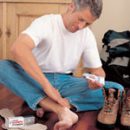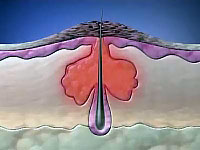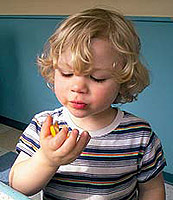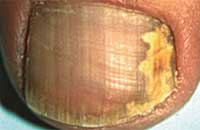Mushroom nails on the legs, photos and features of the disease, types of fungus nails, causes and risk groups. Choice of feet treatment from nail fungus.
Content
- Who is subject to the nail fungus on the legs
- Major clinical manifestations Nail fungus on legs
- How to treat the nail feet fungus
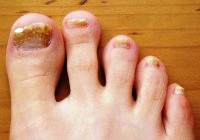
Skin diseases are pretty unpleasant and very uncomfortable for their patient. And of course, it is better not to hurt. But there are situations when we still have to deal with skin «trouble». One of those «guests» — Foot nail fungus, it is observed about 20% of people, and in old age — and at all at 50%. And who warned — He does not ill! Or at least will understand exactly what to do if the fungus still appeared.
Fungal disease — Onichomicosis — strikes the nail plate, forming various stains on it, the strips that are different colors depending on the type of fungus settled under the nail. It occurs both independently and due to the fungus feet. If not engaged in treating, the nail nail mushroom before the base will destroy the nail, moving to the remaining fingers and hands. The protracted ignoring of fungal lesions can cause allergies and, gradually worsening immunity, will lead to the exacerbation of chronic diseases. Distinguish the types of fungi:
- yeast (nail becomes yellow);
- dermatofit (on the nail Longitudinal yellow stripes on the sides or in the center);
- mold (not formed independently, but as a complication of the main disease, not being embedded in the nail plate; nail can be blue, green, black, yellow, brown).
Who is subject to the nail fungus on the legs
Fungush nail strikes both men and women. Less often it appears in children — Due to the rapid growth of the nail plate, since the disease develops quite slowly. Favorable flora for its appearance is the change in the skin of the legs. Normally, it must be acidic alkaline. When the sweat is re-published on the legs, not compliance with the rules of personal hygiene. Acosite medium is neutralized and the protective reaction of the skin is reduced. This is a signal for the invasion of various infections, including fungal. Mushroom loves moisture and darkness, which perfectly provides a stop, sweating and constantly chained in shoes.
The disease develops, starting from the edge of the nail, then gradually captures the entire plate, in the end passing to the remaining fingers. The complexity of treatment of the feet nail fungus depends on the depth of its penetration under the nail. The main risk group and factors provoking the development of fungus:
- Employees of specific professions: chemists, metallurgists, miners, forestry employees, etc.;
- servicemen (mostly soldiers);
- athletes;
- Foot injuries and fingers;
- low-income circles of the population;
- people suffering from mental disabilities;
- Groups of Low Immunity (having chronic diseases such as diabetes, oncology, AIDS, hypovitaminosis, endocrine and gastrointestinal disorders, etc.);
- Long-term intake of antibiotics causes dysbacteriosis and the emergence of nail fungus;
- Patients who have vascular problems of legs affecting the trophic of the lower extremities;
- flatfoot;
- incorrectly selected narrow and uncomfortable shoes; poorly dried shoes, wet insoles;
- Overhead nails on the legs.
You can get infected with a fungal infection from direct carrier by household through shoes, personal homing objects, public areas (beaches, gyms, pools, baths, etc.).
Major clinical manifestations Nail fungus on legs
Symptoms The nail fungus on the legs is very characteristic, but the manifestations are still purely individual and depend on the type of bacteria. Common symptoms can manifest with different intensity, some of them may neither be. Here are common manifestations of Mikosa (fungus) nails:
- itching;
- unpleasant odor;
- Changing the color and thickness of the nail;
- gradual deformation, fragility and bundle of the nail plate;
- inflammation of the incomplete roller (swelling, redness, soreness);
- peeling nail platinum;
- Loss of nail.
How to treat the nail feet fungus

To assign the right treatment, the nail fungus should be followed by the recommendations of the doctor. The sooner you find the fungal defeat of the nail, the more effective will be the treatment. Many options for self-treatment can be found on the Internet — maybe they will get rid of you from the illness, but the most correct decision will appeal to the dermatologist or the Mikogu, who will find out, making the scraping from the affected area, what kind of fungus attacked your nail. And on the basis of these results and the severity of the disease, the doctor will appoint appropriate drug therapy. It is necessary to prepare for the fact that it is not possible to quickly get rid of the nail fungus and the treatment process will be long. You can consider yourself healthy only after the complete restoration of the nail and the negative analysis on the fungus. Subsequently, the recommended prevention measures should be followed.


